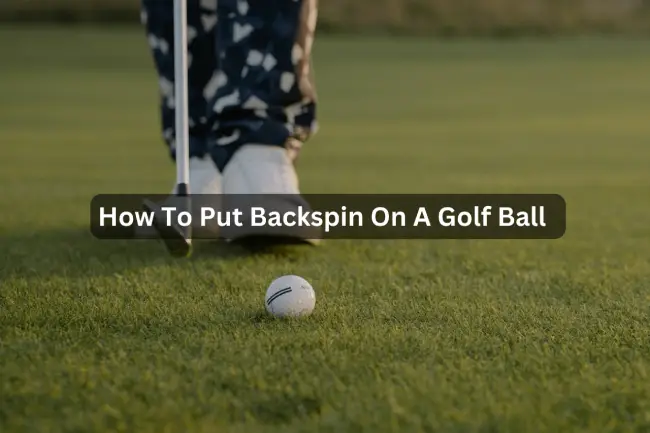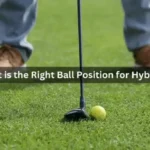Have you ever wondered how professional golfers are able to effortlessly put backspin on their golf ball? It may seem like a complicated technique, but with the right knowledge and practice, you too can master this skill.
In this article, we will explore the step-by-step process of how to put backspin on a golf ball, as well as provide tips and tricks to help you perfect this technique. Whether you are a beginner or a seasoned golfer looking to up your game, mastering the art of backspin can take your golfing skills to the next level.
Understanding the Basics

Before getting into the specifics of how to put backspin on a golf ball, let’s first understand the basics of how it works.
Backspin occurs when the bottom part of the golf ball contacts the clubface before the top part, causing the ball to generate lift and spin backward upon impact. To achieve backspin, you need to strike the ball correctly, control your clubhead speed, and select the appropriate club for the shot at hand.
Step-by-step Guide on How to Put Backspin on a Golf Ball

Step 1: Choose the Right Equipment
Selecting the right equipment is crucial when trying to put backspin on a golf ball. Make sure you are using a wedge with a higher degree of loft, such as a sand wedge or lob wedge. These clubs are designed to help create more spin on the ball.
Step 2: Ball Positioning
Position the golf ball slightly back in your stance, closer to your right foot (for right-handed golfers). Placing the ball back in your stance helps ensure that you make contact with the ball before the ground, which is essential for generating backspin.
Step 3: Open Your Clubface
Before taking your shot, open the clubface slightly. This means angling the clubface away from the target. Opening the clubface adds loft to the club, allowing you to get under the ball properly and create the backspin you desire.
Step 4: Make a Descending Strike
It’s crucial to make a descending strike on the ball to create backspin. Focus on hitting down on the ball with a crisp and clean contact. This downward strike helps compress the ball against the clubface, leading to the desired backspin effect.
Step 5: Accelerate Through Impact
As you swing through the shot, ensure that you accelerate through impact. Maintaining speed through the ball is essential for creating backspin. Avoid decelerating through the shot, as it can result in poor contact and reduced spin.
Step 6: Follow Through
A proper follow-through is essential for generating backspin. After impact, allow your clubhead to continue moving low to the ground along the target line. A complete and smooth follow-through helps optimize spin and control.
Step 7: Practice, Practice, Practice
Putting backspin on a golf ball requires practice and patience. Head to the practice range and experiment with different club positions, ball placements, and swings. Over time, you will develop the feel and technique needed to consistently produce backspin on your shots.
Step 8: Consider Course Conditions
Keep in mind that course conditions can also affect your ability to put backspin on the golf ball. Factors such as the firmness of the greens, the type of golf ball you’re using, and wind conditions can all impact how the ball reacts when it lands.
Factors That Influence the Effectiveness of Backspin in Golf

Let’s delve into the key factors that influence the effectiveness of backspin in golf.
Club Selection and Loft Angle
One of the fundamental factors that influence the ability to put backspin on a golf ball is the type of club being used and its loft angle. Clubs with higher lofts, such as wedges, are designed to create more backspin due to the increased loft angle, which helps generate a steeper angle of descent and more friction between the clubface and the ball. Players looking to add backspin to their shots often opt for clubs with higher lofts to maximize spin potential.
Quality of Contact and Strike
The quality of contact between the clubface and the golf ball plays a significant role in promoting backspin. Striking the ball cleanly and hitting the ball before the ground is crucial for generating optimal backspin. Any dirt, grass, or moisture on the clubface can interfere with the spin generation process, leading to reduced backspin. Therefore, golfers should focus on making solid and clean contact with the ball to maximize the spin rate.
Ball Spin Rate and Compression
The characteristics of the golf ball itself greatly impact its spin rate and the ability to create backspin. Golf balls with urethane covers are known for their ability to grip the clubface better, resulting in increased spin. Additionally, lower compression balls tend to deform more upon impact, leading to higher spin rates. Players seeking to enhance backspin should choose balls specifically designed for spin performance to optimize their shots.
Swing Speed and Technique
The golfer’s swing speed and technique are critical factors in determining the amount of backspin generated. A higher swing speed, combined with the correct angle of attack, can result in a substantial increase in backspin. Furthermore, a descending strike on the ball with an open clubface can promote backspin by creating the necessary friction for the ball to spin backward upon landing. Golfers should strive to develop a consistent and effective swing to achieve the desired spin control.
Course Conditions and Greens
The environmental factors, such as course conditions and green firmness, also influence the effectiveness of backspin in golf. A softer green surface allows the ball to bite and grab, promoting more backspin upon landing. Additionally, uphill or downhill lies, wind direction, and moisture levels can affect how the ball reacts to the spin applied. Being mindful of these conditions and making adjustments to account for them can help golfers maximize their backspin potential.
Common Mistakes to Avoid When Trying to Put Backspin on a Golf Ball
When it comes to mastering the art of putting backspin on a golf ball, it is essential to be aware of the common mistakes that many golfers make. By understanding these mistakes and knowing how to avoid them, you can improve your skills and enhance your overall performance on the course.
Lack of Proper Equipment
Having the right equipment is crucial when trying to put backspin on a golf ball. Using the wrong club or a ball that is not designed for generating spin can hinder your efforts. To achieve optimal backspin, make sure you are using a wedge with a higher loft angle, as this will help create the necessary spin on the ball.
Incorrect Ball Position
The placement of the golf ball in relation to your stance is another common mistake. To generate backspin effectively, the ball should be positioned slightly ahead of the center of your stance. This positioning allows you to make solid contact with the ball first and then the turf, creating the spin you desire.
Swinging Too Fast
Many golfers make the mistake of swinging too fast when trying to put backspin on the ball. A fast swing speed can lead to a lack of control and contact, resulting in shots that lack the desired spin. Focus on a smooth and controlled swing to increase the chances of creating backspin.
Improper Weight Shift
A proper weight shift is essential for generating backspin on a golf ball. Failing to shift your weight correctly from the back foot to the front foot during the downswing can result in poor contact and a lack of spin. Ensure you transfer your weight smoothly to achieve the spin you are aiming for.
Neglecting Backspin Techniques
Another common mistake is neglecting to use proper backspin techniques. To put backspin on a golf ball, focus on making crisp contact with the ball, descending on a slightly steep angle, and following through with your swing. Engaging in proper techniques is crucial for achieving the desired backspin effect.
Lack of Practice
Practice is key to mastering any skill in golf, including putting backspin on the ball. Many golfers make the mistake of not dedicating enough time to practice this specific aspect of their game. Regular practice allows you to refine your technique, improve your consistency, and ultimately enhance your ability to generate backspin.
FAQS
Q: What type of golf ball is best for generating backspin?
A: People often ask which golf balls are ideal for creating more backspin. Generally, balls labeled as “high spin” or “tour” balls are designed to produce more spin. These balls usually have softer covers, which allow for more friction with the clubface and thus generate more backspin.
Q: How does the condition of the golf course affect backspin?
A: The course conditions play a significant role in backspin. Hard ground or short grass can make it difficult to generate spin. Conversely, soft ground or long grass can make it easier. It’s important to adjust your technique based on these conditions to optimize backspin.
Q: What is the best technique for hitting a golf ball to maximize backspin?
A: A steep angle of attack is crucial for generating significant backspin. This involves positioning the ball closer to your back foot and striking it with a downward, steep stroke. It’s also essential to hit the lower part of the golf ball with the lower area of the clubface to increase friction and backspin.
Q: How does the age and condition of a wedge affect its ability to generate backspin?
A: The condition and age of the wedge can significantly affect backspin. Newer wedges with fresh grooves or specially designed high-spin grooves are more effective. It’s also important to ensure that the grooves are well-maintained and not worn out, as this can decrease the wedge’s ability to generate backspin
Q: Can weather conditions affect the amount of backspin on a golf ball?
A: Yes, weather conditions like wetness can impact the spin. When the grass is wet, it’s harder to generate the necessary friction for backspin because water between the club’s grooves and the ball’s dimples reduces grip. Some modern wedges have grooves designed to expel water, helping to maintain spin in wet conditions







